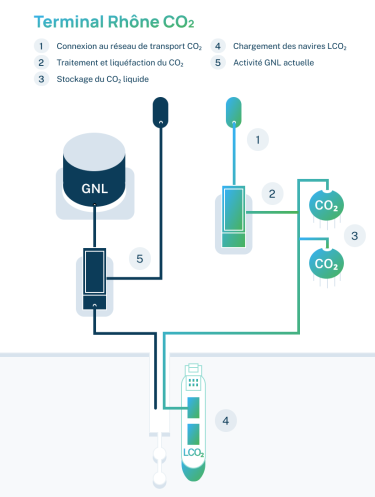Rhône CO2
Rhône CO2, a CO2 transport network and a liquefaction and export terminal for the Rhône Valley, is an infrastructure project designed to decarbonise the industrial sector in the Rhône Valley, promoted by Société du Pipeline Sud-Européen (SPSE) and Elengy.
Succes of the Call for Expression of Interest
It identified the CO2 emitters as well as the promoters of a project to produce synthetic fuels using CO2 who were interested and ready to commit to the development of the project and its infrastructures by 2030.
This project is cofinanced by the European Union

Bringing this project into service would reduce CO2 emissions by 4 million tonnes a year by 2030.
The aim of the Rhône CO2 Project is to develop a set of infrastructures enabling CO2 captured by industrial sites to be transported either to the CO2 liquefaction and export terminal on the existing Fos Tonkin terminal, for export of liquid CO2 to permanent geological storage areas as part of the emerging CCS chain; or to CO2 recovery sites, as part of the emerging CCU chain, along the Rhône valley.
The Rhône CO2 Project is part of the French government's CCS strategy (France 2030) and the Syrius programme, which won the ZIBAC call for projects. It represents a concrete and ambitious commitment to accelerate the decarbonisation of industrial sites in the Rhône Valley.
SPSE and Elengy, promoters of the Rhône CO2 project, are also participating as promoters in the Franco-Italian Callisto Project of Common Interest (PCI), which has been included in the European Union's 6th list of projects, to be made official in April 2024.
A local projet
Perfectly integrated into the local ecosystem, it benefits in part from existing infrastructure along the Rhône Valley and within the Grand Port Maritime de Marseille (GPMM). It will eventually be able to transport CO2 emissions from industrial plants in the Rhône Valley and the Fos-sur-Mer industrial port area, or biogenic CO2 from various industrial processes. It will also help to attract new industrial sites to the region by providing access to a decarbonisation infrastructure.
Reduction of industrial emissions by 4,0 MtCO2/year.
Capture of a majority of unavoidable emissions that cannot be reduced by other measures.
Decarbonising key industrial activities in the region.
Infrastructure that will eventually enable the development of a Carbon Capture and Usage (CCU) activity.
Le terminal de Rhône CO2

Le furtur terminal de Fos Tonkin
